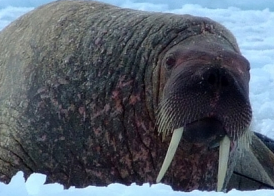Walrus again forced to flee melting arctic sea ice
For the third time in the past four years Walrus again find themselves forced onto land due to retreating sea ice.

We first reported in 2007 of Walrus pushed off Arctic sea ice due to unusually an unusually low Arctic sea ice extent in the eastern Chukchi Sea, where they normally spend their summers breeding and feeding in the shallow waters of the continental shelf.
This year marks the third lowest Arctic sea ice extent since sattellite monitoring of seasonal sea ice melt began, according to the National Snow and Ice Data Center in Boulder, Colorado, continuing the trend toward an ice free summer for the Arctic. Thus far 2010 is tied with 1998 as the warmest year on record. The disappearing ice and warming climate is bad new not only for walrus, but polar bear and other marine mammals that depend on the northern ice.
Recent reports from the US Geological Survey have shown between ten and twenty thousand Walrus have congregated in a "dense clump" at Point Lay, Alaska. Forced onto land, feeding becomes more difficult and raises concerns that the easily spooked animals will stampede, say wildlife experts.
"Our biggest concern right now is stampeding," says Bruce Woods from the US Fish and Wildlife regional office in Alaska, "That's the big risk posed to these animals."
With adult female Walrus typically weighing in at about one ton, the risk is greatest for the younger members of the group. Last year 131 Walrus were trampled when they sought shelter from retreating ice along the shore of Icy Cape, Alaska. Most of the animals killed were juveniles. Similar reports of deadly stampedes have also been reported in the Russian Arctic.
 0
0 







Go to Forum >>0 Comments